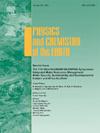Geochemical fingerprinting of hydrocarbon sources using oil-to-oil correlation: Petroleum system evolution in the surghar range, Upper Indus Basin
IF 4.1
3区 地球科学
Q2 GEOSCIENCES, MULTIDISCIPLINARY
引用次数: 0
Abstract
This study focusses on the biomarkers and non-biomarkers analysis performed on different crude oils samples representing three oil fields (Mela, Chanda and Nashpa), from Upper Indus Basin. Various physicochemical & analytical techniques have been employed. Full suite of n-alkanes, high ratio of saturates/aromatics, high American Petroleum Institute (API) gravity, low isoprenoid/n-alkane ratio and low sulfur specify typical light non-biodegraded crude oil. Low sulfur (<1 %) and high pr/ph ratio (1.88–3.7) suggest that the depositional environments of marine organic matter (OM) are typically oxic in nature. The relative distributions of C27–C28–C29 ααα-20R steranes, C19 and C23 tricyclic terpanes (TT) along with Pr/nC17 against Ph/nC18 plot suggests that the crude oils mainly consist of marine OM likely from algal origin. These crude oils are sourced from the mature OM as evidenced from the isomerization ratios of C29 steranes, C3222S/(22S + 22R) homohopanes and carbon preference index. Aromatic biomarkers DBT/P and MPI indicate OM as oxic and mature source of hydrocarbons. The findings of this study enhanced the exploration strategies by identifying the light crude oil characteristics and OM origins, facilitating targeted drilling and extraction efforts in the region. Since the bulk geochemical properties and maturity of Mela, Chanda and Nashpa oil fields are alike, it can be concluded that oil within the reservoirs are quite similar indicating common source rocks.
油气对比的烃源地球化学指纹图谱:上印度河盆地涌流岩段油气系统演化
本研究的重点是对印度河上游三个油田(Mela、Chanda和Nashpa)的不同原油样品进行生物标志物和非生物标志物分析。各种物理化学&;采用了分析技术。全系列正构烷烃、高饱和烃/芳烃比例、高美国石油协会(API)比重、低类异戊二烯/正构烷烃比例和低硫是典型的轻质非生物降解原油。低硫(< 1%)和高pr/ph值(1.88 ~ 3.7)表明海相有机质的沉积环境为典型的含氧环境。C27-C28-C29 ααα-20R甾烷、C19和C23三环萜烷(TT)以及Pr/nC17对Ph/nC18的相对分布表明,原油主要由海相有机质组成,可能来源于藻类。C29甾烷、C3222S/(22S + 22R)同藿烷的异构化比率和碳偏好指数表明,这些原油来源于成熟OM。芳香生物标志物DBT/P和MPI表明OM是含氧和成熟的烃源。该研究结果通过识别轻质原油特征和OM来源,加强了勘探策略,促进了该地区有针对性的钻井和开采工作。Mela油田、Chanda油田和Nashpa油田的整体地球化学性质和成熟度相似,可以认为储层内的油非常相似,表明烃源岩是共同的。
本文章由计算机程序翻译,如有差异,请以英文原文为准。
求助全文
约1分钟内获得全文
求助全文
来源期刊

Physics and Chemistry of the Earth
地学-地球科学综合
CiteScore
5.40
自引率
2.70%
发文量
176
审稿时长
31.6 weeks
期刊介绍:
Physics and Chemistry of the Earth is an international interdisciplinary journal for the rapid publication of collections of refereed communications in separate thematic issues, either stemming from scientific meetings, or, especially compiled for the occasion. There is no restriction on the length of articles published in the journal. Physics and Chemistry of the Earth incorporates the separate Parts A, B and C which existed until the end of 2001.
Please note: the Editors are unable to consider submissions that are not invited or linked to a thematic issue. Please do not submit unsolicited papers.
The journal covers the following subject areas:
-Solid Earth and Geodesy:
(geology, geochemistry, tectonophysics, seismology, volcanology, palaeomagnetism and rock magnetism, electromagnetism and potential fields, marine and environmental geosciences as well as geodesy).
-Hydrology, Oceans and Atmosphere:
(hydrology and water resources research, engineering and management, oceanography and oceanic chemistry, shelf, sea, lake and river sciences, meteorology and atmospheric sciences incl. chemistry as well as climatology and glaciology).
-Solar-Terrestrial and Planetary Science:
(solar, heliospheric and solar-planetary sciences, geology, geophysics and atmospheric sciences of planets, satellites and small bodies as well as cosmochemistry and exobiology).
 求助内容:
求助内容: 应助结果提醒方式:
应助结果提醒方式:


